Text

The Creator's Guide to Comics Devices is OPEN!!!
comicsdevices.com
An online library of visual-narrative devices that are used in the medium of comics and other sequential art.
Happy Halloween! I'm really excited to be finally launching* what is maybe one of my most ambitious, largest work yet.
This online library is the next phase of a research project that began in May 2020, when I first mused on how comics as a field doesn't have a resource that catalogues devices used in the medium. Like, theatre has devices, so does literature, and film! So why shouldn't comics?
I always had an interest in comics studies and analysis. I love reading, making and thinking comics. However most of my knowledge was intuitive - I learned comics from osmosis and experience. This is true for many of my peers. Speaking about comics as a creator is hard, because we don't have a robust system of language. When we had to speak, many of us tend to reach for the language developed for film by film practitioners. If there is language specific to comics, it's either scattered in multiple blogs or hidden away in academic journals.
The Comics Devices library is meant to aggregate everything and everybody into a single hub! After exploring some multiple resources, alongside some original, independent research, here is the first edition!
* The Comics Devices project is still a work-in-progress! It's not final, nor will it ever be. This is why I am seeking contributors to help build this library. Translations, comics examples, etc. There is a lot of work to do! If you are interested, reply to this post or submit an expression of interest on this page.
Have fun everyone!!
(Now time for me to melt x_x)
11K notes
·
View notes
Text
My how 2 make comics is out now, for anyone that wants to start a comic but has no idea how or where 🤓
Get it here! ☀️
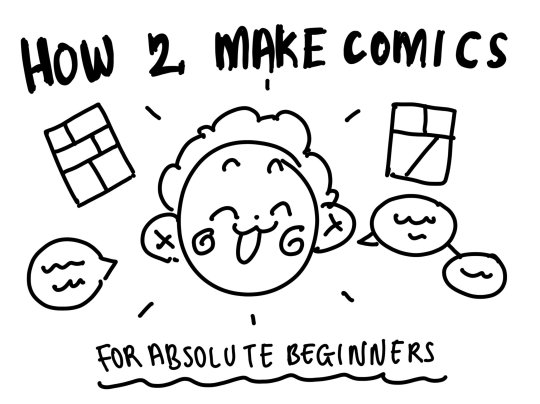

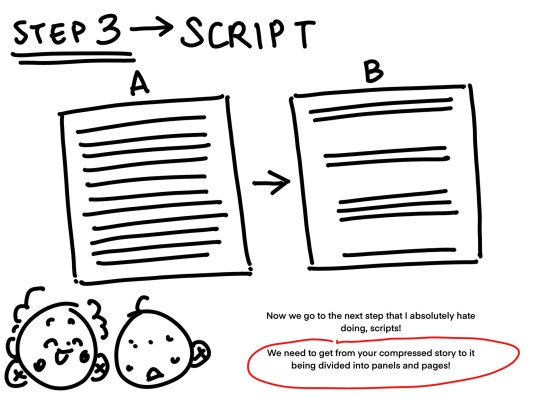
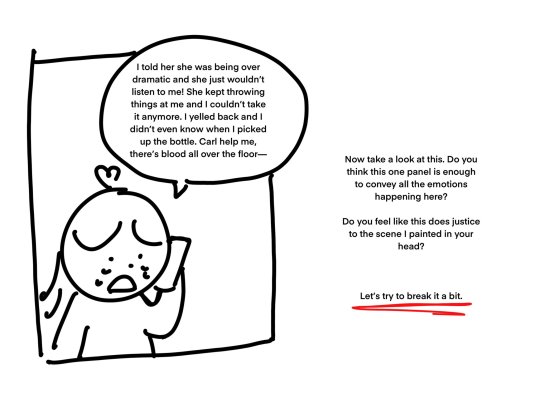

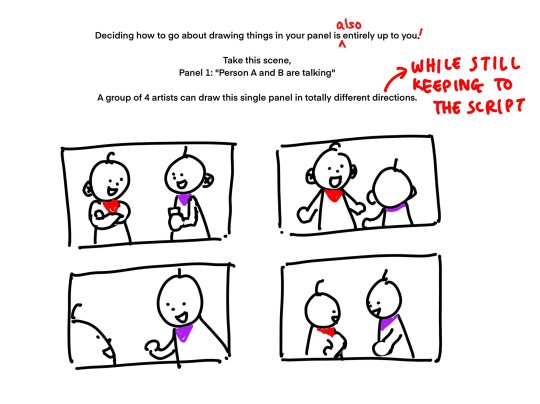
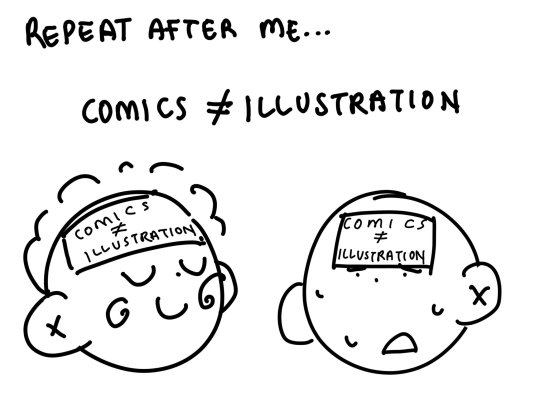

8K notes
·
View notes
Text
Get to Know Your Character Challenge
I wanted to do a small challenge with prompts you can draw (or write about) to get to know your character a little better.
They purposefully don't have a lot of the *actual* character showing because I wanted to focus on their personal belongings, preferences and daily habits instead. That being said, feel free to do with those prompts as you choose!
Day 1: Draw an item that they use on a daily/regular basis. It doesn't need to have a profound meaning or something, it's just something that is around them and handled by them a lot. This can be a tool, a notebook, their favourite coffee mug. If it's something they burn through/fill up/break and replace, draw the last 3 items of that kind during their peak usage.
Day 2: How does their first meal of the day look like? How is it usually set up, what type of dishes, cutlery, etc. do they use? What do they eat most of the days? Draw the setup just before they are about to dig in.
Day 3: Draw them in their designated sleeping space. How does their bed look like, and their sheets? What is their favourite sleeping position? What do they wear to sleep?
Day 4: What do they wear in downtime? Armour is cool and all but no-one can wear that 24/7. What do they wear in their leasure time, what do they feel most comfortable and most themselves in while lounging about and do busy nothing?
Day 5: What furniture item or decoration do you personally think looks atrocious but you know exactly that they would absolutely love it? Draw that item with as much love and appreciation that they would feel over it.
Day 6: How would their shoe rack with their most often worn shoes look like? Do they take good care of their shoes or are they caked in mudd, stained, creased? Would they even use a shoe rack or do the shoes all pile up in a mountain next to it? Which shoes do they wear in different seasons, would the rack look much different then?
Day 7: Draw their favourite flower (or plant if they aren't the flower type). How would they present them? As bouquet in a vase? A single flower in an old jam jar? A simple flower pot? In a garden bed?
Day 8: When they go to bed, what happens with their worn clothes? Do they fold them neatly or do they have The Chair? Does it just pile up on the floor or in a hamper? Do they have a rack where they hang them?
Day 9: What do they look like first thing in the morning? Bags under their eyes? Messed up hair? Pajamas untidy? Drool drying in the corner of their mouth? Pillow creases?
Day 10: They have to cook themselves - what do they attempt? What ingredients do they use? How does the workspace look afterwards? Is the food any good?
Day 11: They caught a mean cold and are too weak to leave the bed. What do they do all day long, where do they have their camp? What are their "need to get better" essentials?
Day 12: Who is the person they trust the most? Would they manage a trust fall? Is that trust mutual?
Day 13: What is their favourite animal? Would they snuggle up if given the chance or do they rather appreciate from afar? Would they cuddle with a plushie instead?
Day 14: How would their ideal room look like? Floorplan, furniture, architectural style? Is it heavily decorated or rather minimalist? How tidy is it? Any knick-knacks of personal value?
Have fun creating!
#art challenge#art resources#writing challenge#writing resources#character building#character design
95 notes
·
View notes
Text
Dice Roll OC Making Game
Tagged by @rannadylin, tagging everyone who wants to be tagged!
Rules: here. As a D&D player I used a D12 instead ;)
Height:
4 - tall
Hair style:
1 - long and curly
Hair Color:
11 - blavk
Eye color:
10 - grey
Top:
8 - nicer tank top
Bottom:
9 - leggings
Shoes:
2 - sandals
Body markings:
7 - vitiligo
Face Accessories:
6 - goggles
Head Accessories:
3 - none
Body Accessories:
3 - shoulder bag
Holding Objects:
5 - umbrella
So:
Here’s Spot.

No idea who he is, but I like him already.
7 notes
·
View notes
Note
Blease tell me more about the beard thing bc if I were to make a campaign I'd fucking love for that to be a thing
OKAY SO PEOPLE WANTED TO KNOW SO I DID MY BEST TO REWRITE IT!
(I HOPE IT MAKES SENSE I AM VERY TIRED AND THIS IS A LOT OF TEXT.)
My HC for Dwarf Beards and Gender Presentation
So the first thing you need to know is the average dwarf will have a primary braid and a secondary pair of braids to either side of it. These two sets of braids denote different things so
Primary Braid

The Primary Braid is the large braid down the center of the beard. Traditionally there are three recognized genders in Dwarven Society, though they do acknowledge an individual’s desire to express themselves in new ways. A traditional 3-strand braid denotes male preferred pronouns, a 4-strand braid denotes female preferred pronouns, and a 2-strand twist denotes a non-binary dwarf with gender-neutral pronouns. These are entirely based on gender expression and not related to sex or genitalia of the dwarf, which is considered a private matter that matters to no one but the dwarf and their mate.
It is possible for a dwarf not to have a primary braid, but this style is considered a time of transition or change in a dwarf’s life, and gender-neutral pronouns should be used until otherwise stated. Some dwarves cut off their primary braid when moving away from their home so as to reevaluate and reinvent themselves in their new residence, but it is not something all dwarves do.
The majority of dwarves use he/him pronouns outside of all-dwarven societies due to gender stigma against female presenting dwarves by other species, but in an all-dwarven society the mix of genders will be fairly even.
To save timelines I put the rest under the cut, but I talk about more below!
Weiterlesen
8K notes
·
View notes
Text
Here is a free pdf of the players handbook
Here is a free pdf of xanathars guide to everything
Here is a free pdf to monsters manual
Here is a free pdf to tashas cauldron of everything
Here is a free pdf to dungeon master’s guide
Here is a free pdf to volo’s guide to monsters
Here is a free pdf of mordenkainen’s tomb of foes
For all your dnd purposes
223K notes
·
View notes
Text


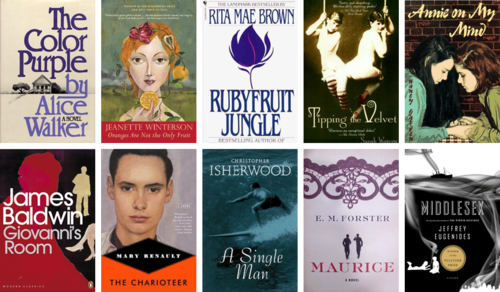
Lesbian/Bi:
The Color Purple by Alice Walker (1982)
Oranges Are Not the Only Fruit by Jeanette Winterson (1985)
Rubyfruit Jungle by Rita Mae Brown (1973)
Tipping the Velvet by Sarah Waters (1998)
Annie on My Mind by Nancy Garden (1982)
Gay/Bi:
Giovanni’s Room by James Baldwin (1956)
The Charioteer by Mary Renault (1953)
A Single Man by Christopher Isherwood (1964)
Maurice by E. M. Forster (1971)
Intersex:
Middlesex by Jeffrey Eugenides (2002)



Gay/Bi:
More Than This by Patrick Ness (2013)
Hero by Perry Moore (2007)
Grasshopper Jungle by Andrew Smith (2014)
Lesbian/Bi:
Ash by Malinda Lo (2009)
Huntress by Malinda Lo (2011)
Adaptation (Adaptation #1) by Malinda Lo (2012)
The Dark Wife by Sarah Diemer (2011)
Hild by Nicola Griffith (2013)
Trans, Intersex, and Multiple Categories:
Pantomime (Micah Grey #1) by Laura Lam (2013)
Love in the Time of Global Warming by Francesca Lia Block (2013)


Lesbian/Bi:
Ask the Passengers by A. S. King (2012)
The Miseducation of Cameron Post by Emily M. Danforth (2012)
Everything Leads to You by Nina LaCour (2014)
The House You Pass on the Way by Jacqueline Woodson (1997)
Kissing Kate by Lauren Myracle (2007)
The Necessary Hunger by Nina Revoyr (1997)
Lies We Tell Ourselves by Robbin Talley (2014)
Starting From Here by Lisa Jenn Bigelow (2012)
Gay/Bi:
Aristotle and Dante Discover the Secrets of the Universe by Benjamin Alire Sáenz (2012)
Chulito by Charles Rice-González (2010)
Two Boys Kissing by David Levithan (2013)
Blue Boy by Rakesh Satyal (2009)
The God Box by Alex Sanchez (2007)
Trans (includes overlapping categories):
Luna by Julie Anne Peters (2006)
I am J by Cris Beam (2011)
Almost Perfect by Brian Katcher (2009)
Freakboy by Kristin Elizabeth Clark (2013)
Parrotfish by Ellen Wittlinger (2007)

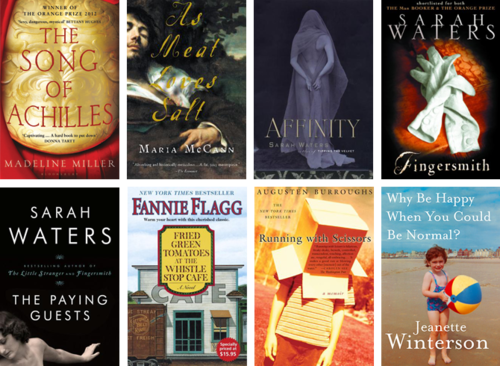
Gay/Bi:
The Song of Achilles by Madeline Miller (2011)
As Meat Loves Salt by Maria McCann (2001)
Lesbian/Bi:
Affinity by Sarah Waters (1999)
Fingersmith by Sarah Waters (2002)
The Paying Guests by Sarah Waters (2014)
Fried Green Tomatoes at the Whistle Stop Cafe by Fannie Flagg (1987)
Non-Fiction (Autobiographical):
Running with Scissors by Augusten Burroughs (2002)
Why Be Happy When You Could Be Normal? by Jeanette Winterson (2011)

(Since queer representation remains relatively scarce in this genre, note that while many of these books DO discuss queer themes at length — and that all contain at least one queer character — a few do not revolve around said character(s) and/or are not centered around queer themes.)

Middle Grade:
Better Nate Than Ever series by Tim Federle (2013-)
So Hard to Say by Alex Sanchez (2006)
See You at Harry’s by Jo Knowles (2012)
The House of Hades (The Heroes of Olympus #4) by Rick Riordan (2013)
Marco Impossible by Hannah Moskowitz (2013)
Children’s:
And Tango Makes Three by Justin Richardson, Peter Parnell, and Henry Cole (2005)
King & King by Linda de Haan, Stern Nijland (2003)


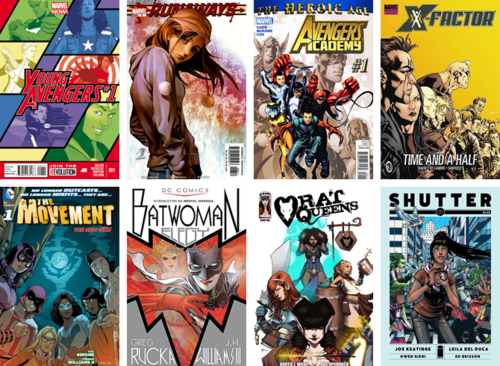
(All contain at least one queer character, but do not necessarily revolve around them.)
Marvel:
Young Avengers (v2) (Official: v1 / v2) by Allan Heinberg, Jim Cheung, Kieron Gillen, and Jamie Mckelvie
Runaways (Official) by Brian K. Vaughan, Adrian Alphona, and more
Avengers Academy (Official) by Christos Gage, Mike McKone, and various artists
X-Factor: Time and a Half (from X-Factor v3) (Official) by Peter David and Valentine de Landro
DC:
The Movement (Official) by Gail Simone and Freddie E. Williams II
Batwoman: Elegy (Official) by Greg Rucka and J.H. Williams III
Image:
Rat Queens (Official) by Kurtis J. Wiebe and Roc Upchurch
Shutter (Official) by Joe Keatinge and Leila del Duca


Skim by Mariko Tamaki and Jillian Tamaki (2008)
Fun Home: A Family Tragicomic by Alison Bechdel (2006)
Are You My Mother? by Alison Bechdel (2012)
Drama by Raina Telgemeier (2012)
Marbles: Mania, Depression, Michelangelo, and Me by Ellen Forney (2012)
Le bleu est une couleur chaude by Julie Maroh (2010)
Calling Dr. Laura: A Graphic Memoir by Nicole J. Georges (2013)
Wandering Son (Wandering Son #1) by Shimura Takako, translated by Matt Thorn (2003, translation: 2011)

On tumblr: bisexual-books, queerbookclub, queerbookrecs, and diversityinya (run by YA authors Cindy Pon and Malinda Lo)
Outside of tumblr, Lee Wind’s blog — I’m Here. I’m Queer. What the hell do I read? — contains a myriad of queer booklists.
In addition, goodreads.com has shelves for just about everything; one look at its Queer, Lesbian, Gay, Bisexual, and Transgender ones can uncover some of the many books I couldn’t fit on this one post!
Enjoy!
30K notes
·
View notes
Text
“What it’s Like to be” Masterlist
What it’s Like to be Abrosexual
What it’s Like to be Agender
What it’s Like to be Aroflux
What it’s Like to be Aromantic
What it’s Like to be Asexual
What it’s Like to be Bigender
What it’s Like to be Biromantic
What it’s Like to be Bisexual
What it’s Like to be Demigirl
What it’s Like to be Demiromantic
What it’s Like to be Demisexual
What it’s Like to be Gay
What it’s Like to be Genderfluid
What it’s Like to be Genderflux
What it’s Like to be Genderqueer
What it’s Like to be Gendervoid
What it’s Like to be Lesbian
What it’s Like to be Lithromantic
What it’s Like to be Maverique
What it’s Like to be Nebularomantic
What it’s Like to be Neutrois
What it’s Like to be Nonbinary
What it’s Like to be Panromantic
What it’s Like to be Pansexual
What it’s Like to be Polysexual
What it’s Like to be Queer
What it’s Like to be Quoigender
What it’s LIke to be Quoiromantic
What it’s Like to be Transmasculine
21K notes
·
View notes
Text
Hello! I'd like to share with you a character work game! I call it "Six Secrets" and honestly it's a work in progress but I'm sharing it anyway
List six secrets that your character has.
1 is an open secret
2 is a secret the people close to your character know
3 is a secret that your character wouldn't really care about getting out
4 is a secret exactly one person knows anything about
5 is a secret no one knows about but they sort of want to come out/to tell someone
6 is a secret no one knows and they desperately don't want anyone to know about.
You can also decide who knows and how
The secrets don't have to have anything to do with your actual plot! The secrets can have super low or super high stakes! It doesn't matter! But you will absolutely have a better idea of your character's intentions and state of mind, and you may wind up coming up with some new plot points/obstacles to play with
10K notes
·
View notes
Video
after eight years, I finally updated my huge Historical Fashion Reference & Resources Doc! Now in the form of a MUCH more easily updated Google Doc with better organization, refreshed links, and five more pages of books and online resources.
I know tumblr hates links, but it’s worth it for a doc that I can now update with far more regularity going forward! RIP to the original, you did your duty for far longer than you should have. 😔🙏🏼
24K notes
·
View notes
Text
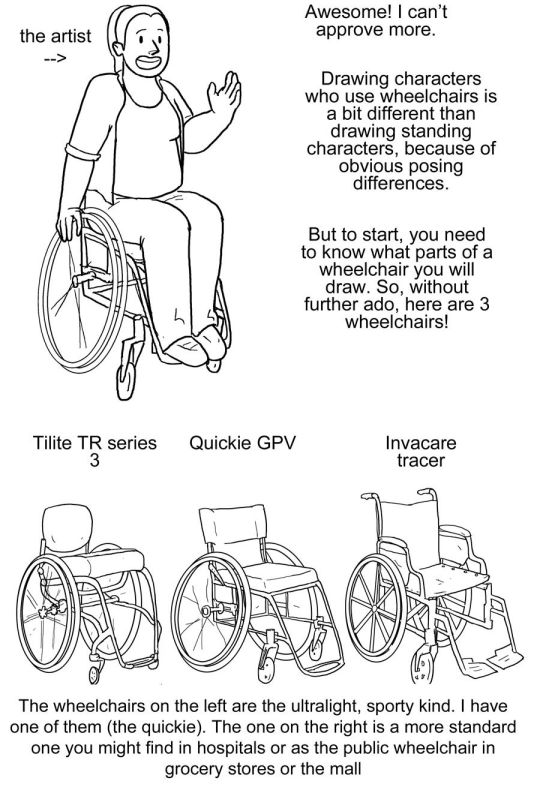
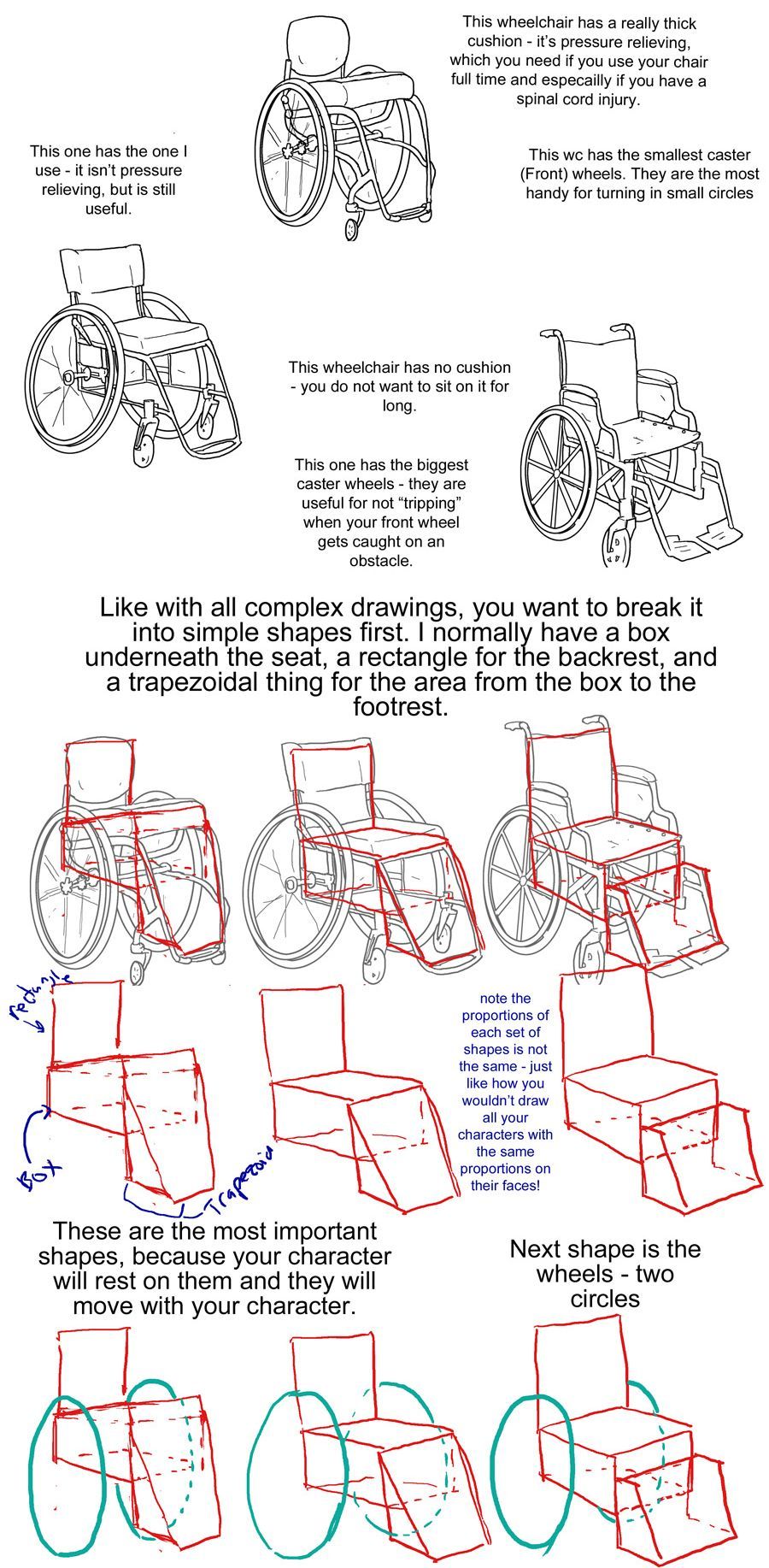
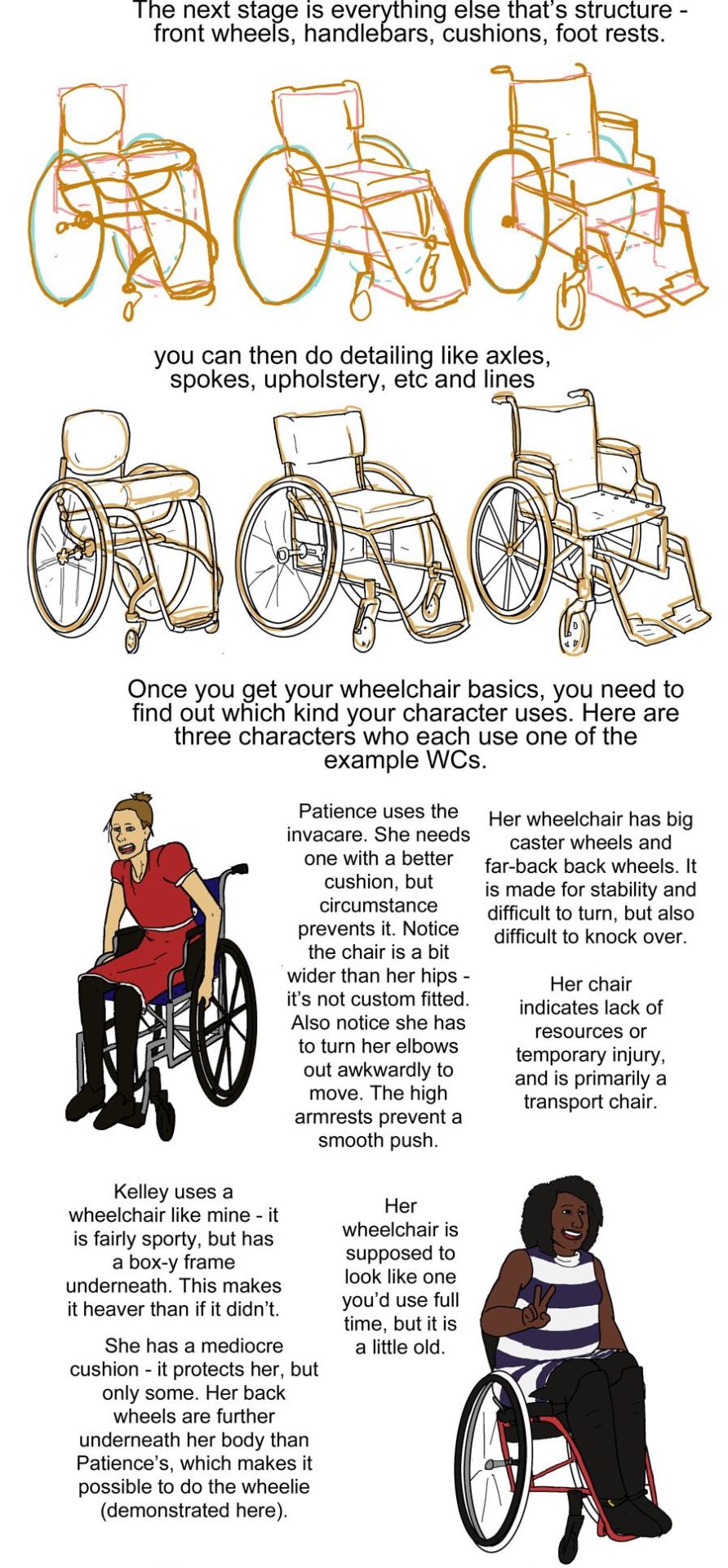
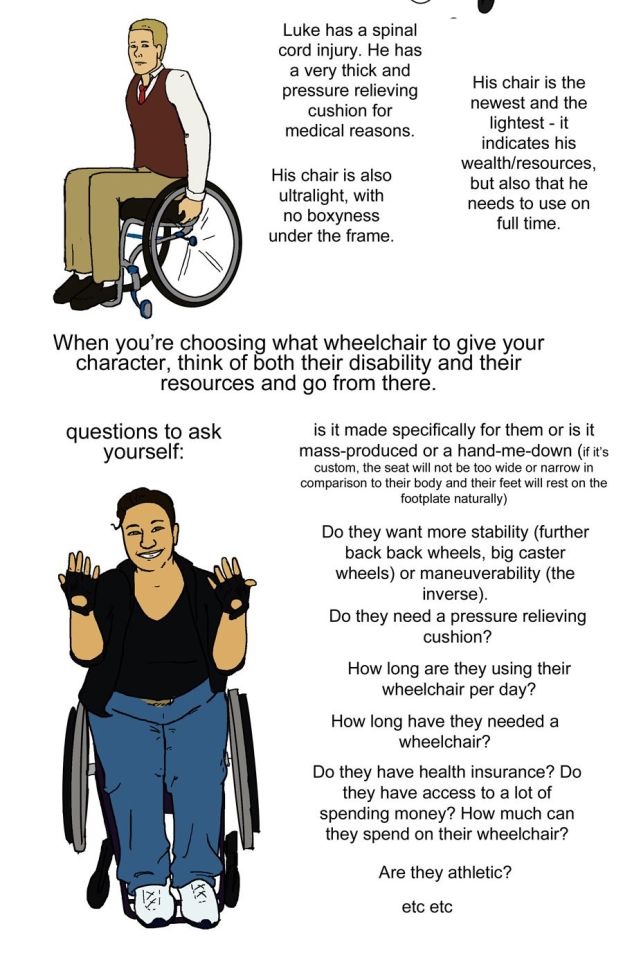
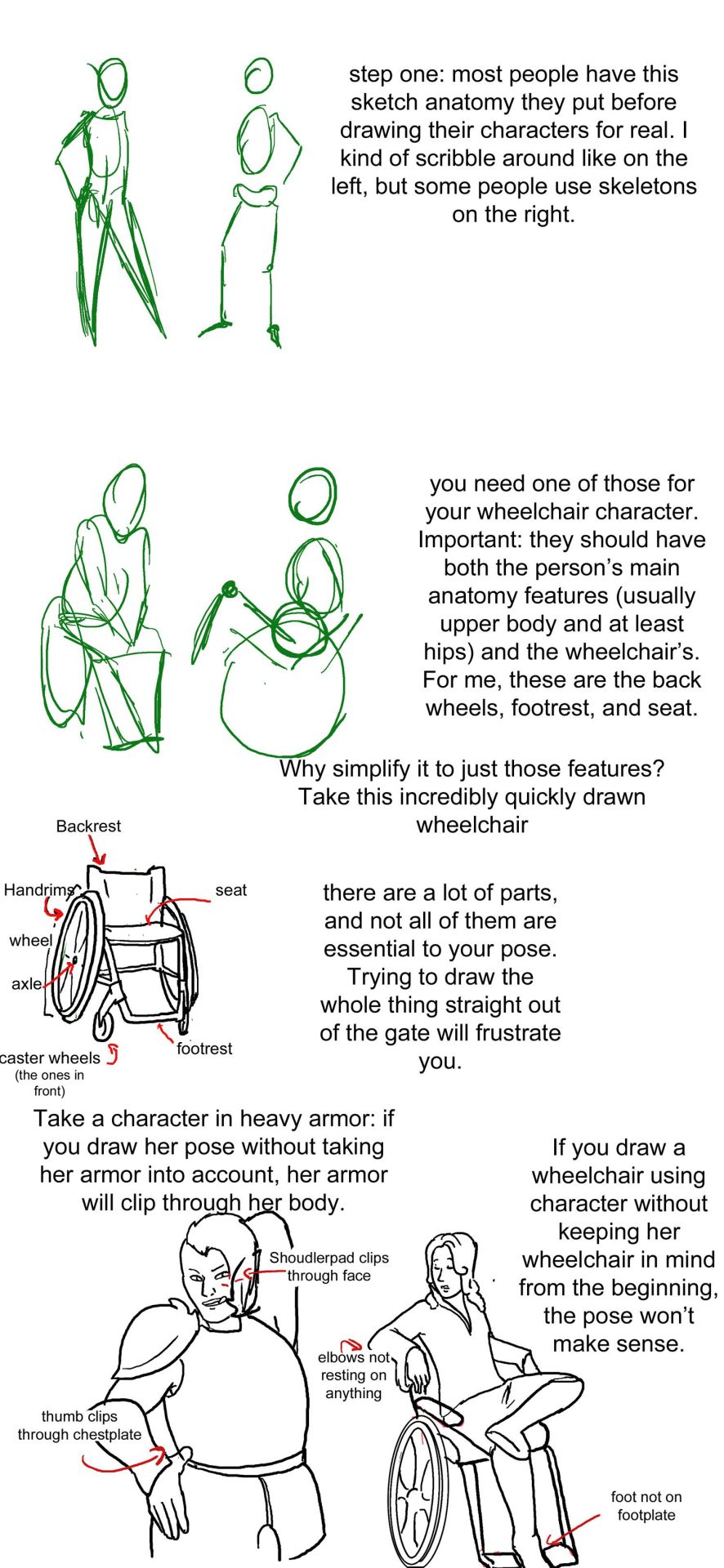
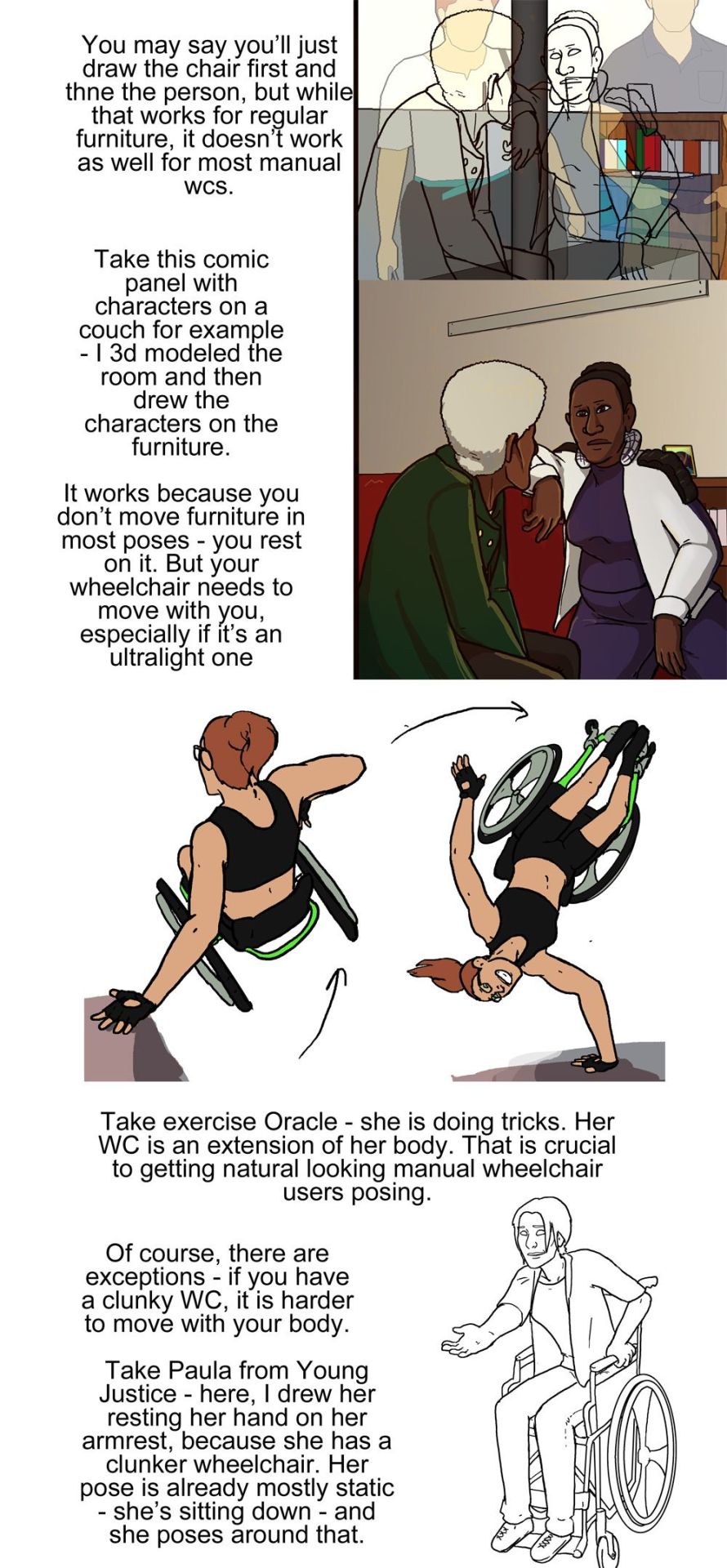
Manual Wheelchair Tutorial by Fade31415
So... I technically drew this 3 years ago but forgot to post it. I think I was going to clean up the end and make a nice recap, but I ran out of steam and then just left it as a wip for years. I got reminded of it because I was talking to a friend about how to draw wheelchairs today.
This covers most of what I view as the most common errors when it comes to drawing characters who use manual wheelchairs. I hope it helps you a lot.
Image description is in alt text, but there is a back up image description under the cut in case that does not work for some reason
[image description: a 4 picture long wheelchair tutorial. the background is white and the text, when it appears, is black and in calibri. each step will be labeled with "Step #" and a description of the drawing next to it, and "text" and then the text that is written to explain it to follow.
Step one text: So, you want to draw a character who uses a manual wheelchair? Awesome! I can't approve more. Drawing characters who use wheelchairs is a bit different than drawing standing characters, because of obvious posing differences. But to start, you need to know what parts of a wheelchair you will draw. So, without further ado, here are 3 wheelchairs!
Step one image: a simplified drawing of a chubby woman sitting in a quickie GPV manual wheelchair and resting her hand on the handrim of one of the wheels. this is labeled "the artist"
step two: next there is a lineart drawing of three wheelchairs. one is a tilite TR series 3. this is an ultralight wheelchair with a bucket seat (the back is lower than the front), a big cushion and a short backrest that kind of contours to the back of the person who would sit in it. the caster wheels (front wheels) are very small and the footrest is just two little metal bars. next image is a quickie GPV. this is also an ultralight wheelchair with a low back, but its caster wheels are slightly larger, the back has regular upholstery (it does not look like it was made to conform to the back of the person who sits there) and the frame is boxier -- there is no bar underneath the seat where the wheels would attach, rather each wheel is attached to the side of the chair. the next wheelchair is an invacare tracer. it is how most people imagine wheelchairs when they hear 'wheelchair'. it has no cushion and it has a high backrest with handles. it has high armrests that would be comfortable to rest your elbows on if you were just sitting. the wheels are not bicycle wheels like the previous two but are rather plastic. it has big footrests and big caster wheels.
text: the wheelchairs on the left are the ultralight, sporty kind. I have one of them (the quickie). the one on the right is a more standard one you might find in hospitals or as the public wheelchair in grocery stores or the mall.
step three: first is text to accompany the tilite. "This wheelchair has a really thick cushion - it's pressure relieving, which you need if you use your chair ufll tiem and especially if you have a spinal cord injury. This wc has the smallest caster (front) wheels. They are hte most handy for turning in small circles." next there is text to accompany the quickie gpv: "This one has the one I use -- it isn't pressure relieving, but is still useful." next is text to accompany the invacare: "this wheelchair has no cushion - you do not want to sit on it for long. This one has the biggest caster wheels - they are useful for not 'tripping' when your front wheel gets caught on an obstacle.”
step four text: like with all complex drawings, you want to break it into simple shapes first. I normally have a box underneath the seat, a rectangle for the backrest, and a trapezoidal thing for hte area from the box to the footrest. these are the most important shapes, because your character will rest on them and they will move with your character.
step four image: the lineart of each wheelchair has been put on reduced opacity, so we can see the square representing the backrest of each seat (the square is the smallest for the tilite and biggest for the invacare), the box for each seat and area underneath it, and the trapezoid for the footrests. the next step labels the images of these simplified shapes as the lineart is removed. "Note the proportions of each set of shapes is not the same - just like how you wouldn't draw all your characters with the same proportions on their faces!"
step 5: we see the same shapes to form the wheelchair, but now with blue circles drawn where the back wheels would be.
text: next shape is the wheels - two circles
step six: next we see the wheels and shapes have been reduced in opacity and the basic structure of everything about each wheelchair: footrests, caster wheels, upholstery details, axles has been drawn on in orange.
text: the next stage is everything else that's structure - front wheels, handlebars, cushions, footrests.
Step seven: we see the lineart on top of the lowered opacity sketch.
text: you can then do detailing like axles, spokes, upholstery, etc and lines
step eight: next we see three drawings of different characters. there is patience, a skinny white woman sitting in a blue invacare wheelchair. kelley, a slightly chubby black woman wearing a stripey dress sitting in a red quickie gpv wheelchair and doing a wheelie while smiling. then luke, a white man with short blond hair wearing khaki pants. he is sitting in a tilite chair.
text: once you get your wheelchair basics, you need to find out which kind your character uses. here are three characters who each use one of the example WCs. patience uses the invacare. she needs one with a better cushion, but circumstance prevents it. Notice the chair is a bit wider than her hips - it's not custom fitted. Also notice she has to turn her elbows out awkwardly to move. the high armrests prevent a smooth push. her wheelchair has big caster wheels and far-back back wheels. it is made for stability and difficult to turn,but also difficult to knock over. Her chair indicates a lack of resources or temporary injury, and is primarily a transport chair
kelley uses a wheelchair like mine - it is fairly sporty, but has a box-y frame underneath. this makes it heaver than if it didn't.she has a mediocre cushion - it protects her, but only some. her back wheels are further underneath her body than Patience's, which makes it possible to do the wheelie (demonstrated here). her wheelchair is supposed to look line one you'd use full time, but it is a little old.
luke has a spinal cord injury. he has a very thick pressure relieving cushion for medical reasons. his chair is also ultralight, with no boxyness under the frame. his chair is the newest and lightest - it indicates his wealth/resources, but also that he needs to use on full time.
step nine: just a drawing of me sitting in my wheelchair holding my hands up to show fingerless wheelchair gloves. we're looking at me from above.
text: when you're choosing what wheelchair to give your character, think of both their disability and their resources and go from there. questions to ask yourself: is it made specifically for them or is it mass-produced or a hand-me-down (if it's custom, the seat will not be too wide or narrow in comparison to their body and their feet will rest on the footplate naturally). do they want more stability (further back back wheels, big caster wheels) or maneuverability (the inverse). do they need a pressure relieving cushion? how long are they using their wheelchair per day? how long have they needed a wheelchair? Do they have health insurance? do they have access to a lot of spending money? How much can they spend on their wheelchair? are they athletic etc etc
posing steps:
step one: a sketch of two people standing up. one just shows the outline of a person's body, with legs that are ind of triangle shaped, the other shows a sketched pelvis and rib cage to go along with the bones of the legs and arm. text: step one: Most people have this sketch anatomy they put before drawing their characters for real. I kind of scribble around like on the left, but some people use skeletons on the right.
step two: there are now too sketched pictures of people in wheelchairs. one shows lightly traced human form (arms articulated, curve for a stomach, legs that are kind of triangle shaped and pointing down) sitting in a wheelchair that is just the sketch of footrests and wheels. the other sketch shows the sketch of a body with a circle for hips and an oval for a rib cage and the person doing a wheelie (lifting the front end of the wheelchair off the ground and leaning back). their wheelchair is also sketched out and defined by a circle for their wheels and 2 lines, 1 of the seat and 1 for the backrest. text: you need one of those for your wheelchair character. important: they should have both the person's main anatomy features (Usually upper body and at least hips) and the wheelchair's. for me, these are the back wheels, footrest, and seat. why simplify to just those features? Take a look at this incredibly quickly drawn wheelchair.
step three: there is a lineart drawing of a manual wheelchair with slightly cambered (angled towards the seat) wheels, a backrest, and a footrest. the frame is light and there are no handlebars. there are labels pointing to different parts of the wheelchair: Backrest, handrims, wheel, axle, seat, footrest, and caster wheels (the ones in front). text: there are a lot of parts, and not all of them are essential to your pose. trying to draw the whole thing straight out of the gate will frustrate you.'
step four text: take a character in heavy armor: if you draw her pose without taking her armor into account, her armor will clip through her body. if you draw a wheelchair using character without keeping her wheelchair in mind from the beginning, the pose won't make sense.
step four image: next we see two lineart drawings of different characters. one is a bulky woman wearing plate armor. her hand is on her hip and she is trying to scratch her back with the other hand. there is the label "shoudlerpad clips through face" and "thumb clips through chestplate." the next drawing shows a woman in a wheelchair with one foot rested on her knee and her arms rested back, such that they would be rested on the back of a regular chair, but the back of her wheelchair is not wide enough for them to actually be resting on anything. the text here reads "elbows not resting on anything" and "foot not on footplate"
step five: there are two images, one is lineart on top of a 3d modelled apartment with sketchup, the other is a colored in version of that lineart with the background also colored in and no longer a 3d modelled screencap two characters, one old woman wearing a green jacket and one younger woman wearing a white shirt and blue undershirt, are sitting on a couch. the old woman is leaning forward and the young woman is resting her arm on the couch. behind the young woman is a bookshelf.
step five text: you may say you'll just draw the chair first and then the person, but while that works for regular furniture, it doesn't work as well for most manual wcs. take this comic panel with characters on a couch for example - I 3d modeled the room and then drew the characters on the furniture. it works because you don't move furniture in most poses - you rest on it. but your wheelchair needs to move with you, especially if it's an ultralight one.
step six image: there is a flat color drawing of barbara gordon in her wheelchair. she is wearing a black sportsbra and black shorts. in the first image we see she is doing tricks in her chair, zooming through the air (as if she has just launched herself off the ground in a skater park or somethign) while her left hand is resting on a structure and her right hand is heading towards the right handrim. the next image shows her right hand planted on the ground and her chair and body above her, such that she is briefly doing a one-handed handstand, but the motion line indicates that she is moving and this will not last. her left arm is near the handrim of her left wheel.
text: take exercise Oracle - she is doing tricks. Her WC is an extension of her body. That is crucial to getting natural looking manual wheelchair users after posing.
step seven: we see a lineart drawing of paula from young justice. she is sitting in a standard manual wheelchair with high armrests (goes up to the bottom of her ribs probably) and a high backrest (goes up to just below her shoulderblades). she is setting her hand on the armrest, leaning forward, and holding her other hand out.
text: of course, there are exceptions - if you have a clunky WC, it is harder to move with your body. Take Paula from young Justice - here, i drew her resting her hand on her armrest, because she has a clunker wheelchair. her pose is already mostly static - she's sitting down - and she poses around that.
49K notes
·
View notes
Text
ADHD Tips for Writers, Take 2
Hiy'all, I'm back on my shit because my old "ADHD tips for writers" post is the like only post I still see in my notes at all times and there's a few problems with it so I'd like a do-over plz
Anyways, the obligatory disclaimer: I find ADHD tips are super useful for writers whether they have ADHD or not, so feel free to read & use the tips in this post if you find they apply.
Respect your fatigue. Here's the thing about ADHD. You get fatigued super easily. We know this. But when I say "respect your fatigue," I only partly mean it as taking breaks when you're tired. Before you decide you're too burned out to write, weigh this: people who have ADHD wear themselves out MORE when they have nothing to mentally chew on. Sometimes respecting your fatigue means respecting that you need to paradoxically put in more effort to do your writing, because that will actually slow your fatigue down in the end. Try it, if it doesn't work take a break.
Get ahold of the pressure level. Pressure is a tool for you to motivate yourself, you should NOT be under it at all times. How to do this? Adjust your goals, don't marry your outline.
Set the right goals. Stressed by wordcount but can work by hour? Can't focus for any stretch of time but can hyper-focus if you promise to get one scene done? And consider mix-and-matching. You can make a goal of getting a scene done in one day, but if that scene happens to go over 1k then it's reasonable to quit. If you set a goal that is actually attainable, it's safer to put pressure on it.
Confines begone. Seriously, don't try to make yourself do things in a Stupidly Specific Way. You do NOT need to draft in submittable manuscript format. You DON'T need it to fit your outline exactly. It doesn't need to fit a genre, it doesn't need to appeal to a specific audience, it doesn't need to be what it was in your head. If working with those things slows you down or makes you stressed, YEET.
Pavlov, Profit. I write on my bed with a scented candle while wearing a certain pair of pants. I use a specific playlist to cue me in to which WIP I'm working on. Maybe I pull out a specific stim toy I don't use otherwise. I write at a certain time of day and look at certain pictures while I do it. I drink water with lemon in it when I don't if I'm not writing. The words flow like a crystalline river and I don't even know how.
No I'm serious I cannot emphasize enough how powerful Pavlov is, literally it is the BIGGEST hack of my life. You train your brain to identify what "writing mode" is and afterward if you just set up the trappings of "writing mode" brain goes "OH OK NOW WE WRITE." I can't even
Throw slumps off with word wars and writing sprints. As always, word of caution for those who have trouble with their self-expectations: if you can't make the words sprint, that's ok! This is super useful to me and others for kicking off a writing session, but if you struggle to focus for any length of time then don't stress! But I do seriously recommend trying out word sprints at whatever time limit works for you, because after you've done it the words happen so. Much. Easier. I'll personally rev up with 5 mins, 15 mins then 30 mins. That 30 gets into the "this might actively burn me out" territory, so be cautious. It really might not work for you.
Don't underestimate minor changes. Font! Color! Screen blue-light! Using a different word processor! Tweak and change, hack the brain.
Journal about it. When I get stuck on a project, I will literally open a new file and just ramble into the file like I'm explaining the project to someone. It's rubber duck decoding, except it exercises the same muscles you use to do the actual writing. Makes for a great warm-up or dust-off.
Identify if/when you need outside support. Sometimes you need to ramble to a friend in order to kick a slump, sometimes you need community support for a WIP through the whole process. It might change for each case.
External incentives generally don't work. Honestly, I find external incentives don't work for me point blank, let alone to get myself to write. Maybe you can drag yourself across the ground like that sad cat on a harness by promising yourself a bowl of ice cream, but you're just not going to do your best work like that. You need to foster genuine motivators.
External motivators are different from incentives. If you're writing because someone is waiting to read it, that's not an incentive, it's a motivator.
Internal motivators that can be useful: fostering excitement for WIP elements (not by saying "if I write x words I get to make another moodboard, more like going ahead with the moodboard and using it to increase ur excitement), making a bar chart of progress and watching it grow, de-pressurizing writing so much that it can be used as a wind-down.
Are you a pantser who lives in a constant state of writer's block? No you're not you're not, you need to develop some sort of plan if you're getting stuck constantly. It doesn't need to be a super locked-in plan (I don't recommend those in general), but using lighthouse planning or developing some guiding element is important.
Contrarian hack: have someone who isn't a writer write the thing your're stuck on for you. (Consider: have AI write it for you.) Read it. Dislike it and use the motivation to write yourself. Profit.
Struggling to get started because the WIP is too daunting? Don't work on the whole WIP. Work on This Scene. This Scene too daunting? Work on This Small Part of This Scene. This Small Part too big? Work on the next sentence. Work on opening the WIP. Break the steps down as small as you need to.
SO. Be mindful of what you expect from yourself, do NOT let others decide how your process works, and do NOT hold yourself to any standard that inhibits you. Do what feels good both in the moment and after, because that is a good indicator you're doing healthy, sustainable writing.
4K notes
·
View notes
Text


refseek.com
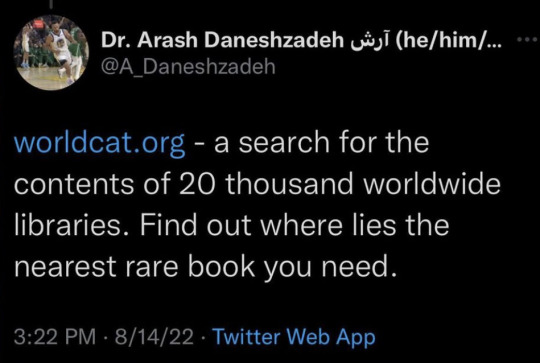
www.worldcat.org/

link.springer.com

http://bioline.org.br/
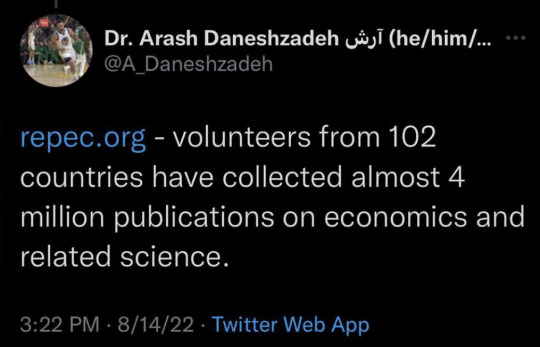
repec.org

science.gov

pdfdrive.com
282K notes
·
View notes
Text
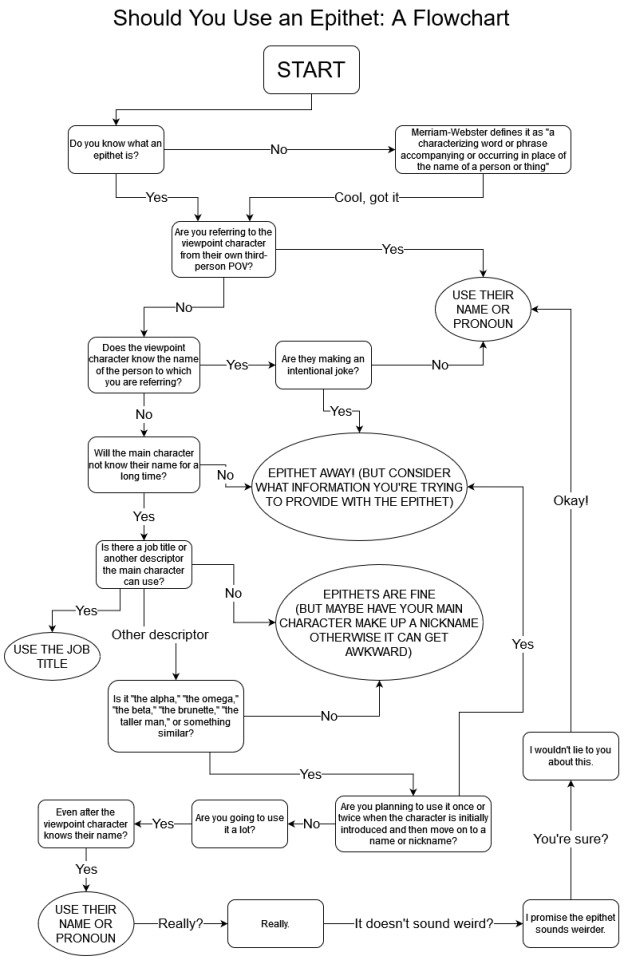
So I was thinking about epithets yesterday and how when they're used well they really add to the work and when they're used poorly it feels like the author has thrown a cinderblock in front of you while you're moving at a brisk walk, and then I got floostered (flu vaxx and covid booster) and managed to edit this ugly but hopefully helpful flowchart together through my flooster fever.
The question I always come back to is, "How would I, as the viewpoint character, think about this other character?" I think about my wife by her name or her relationship to me. I don't think of her as "the blue-haired woman," or "the taller woman."
This obviously doesn't cover every single permutation of epithet use out there in the would, but if I can help one person avoid writing, "Scarlett walked into the kitchen, hungry and annoyed about it. The redheaded woman found she had no snacks and grumbled," it'll be worth it.
(This is not a callout post for anyone in particular. It's just intended as general writing advice, because I had to figure out a lot of this shit for myself when I first started telling stories!)
5K notes
·
View notes
Text
Things that will make your computer meaningfully faster:
Replacing a HDD with an SSD
Adding RAM
Graphics cards if you're nasty
Uninstalling resource hogs like Norton or McAfee (if you're using Windows then the built-in Windows Security is perfectly fine; if you're using a mac consider bitdefender as a free antivirus or eset as a less resource intensive paid option)
Customizing what runs on startup for your computer
Things that are likely to make internet browsing specifically meaningfully faster:
Installing firefox and setting it up with ublock origin
adding the Auto Tab Discard extension to firefox to sleep unused tabs so that they aren't constantly reloading
Closing some fucking tabs bud I'm sorry I know it hurts I'm guilty of this too
Things that will make your computer faster if you are actually having a problem:
Running malwarebytes and shutting down any malicious programs it finds.
Correcting disk utilization errors
Things that will make your computer superficially faster and may slightly improve your user experience temporarily:
Clearing cache and cookies on your browser
Restarting the computer
Changing your screen resolution
Uninstalling unused browser extensions
Things that do not actually make your computer faster:
Deleting files
Registry cleaners
Defragging your drive
Passively wishing that your computer was faster instead of actually just adding more fucking RAM.
This post is brought to you by the lady with the 7-year-old laptop that she refuses to leave overnight for us to run scans on or take apart so that we can put RAM in it and who insists on coming by for 30-minute visits hoping we can make her computer faster.
119K notes
·
View notes
Text
New writing rule: Checkov’s friend
If you introduce a named character with a relationship to a protagonist, their character arc must be resolved in a way that feels reasonable and satisfying
Which is to say: they can’t just dissappear when they’re no longer a convenient plot device
112K notes
·
View notes
